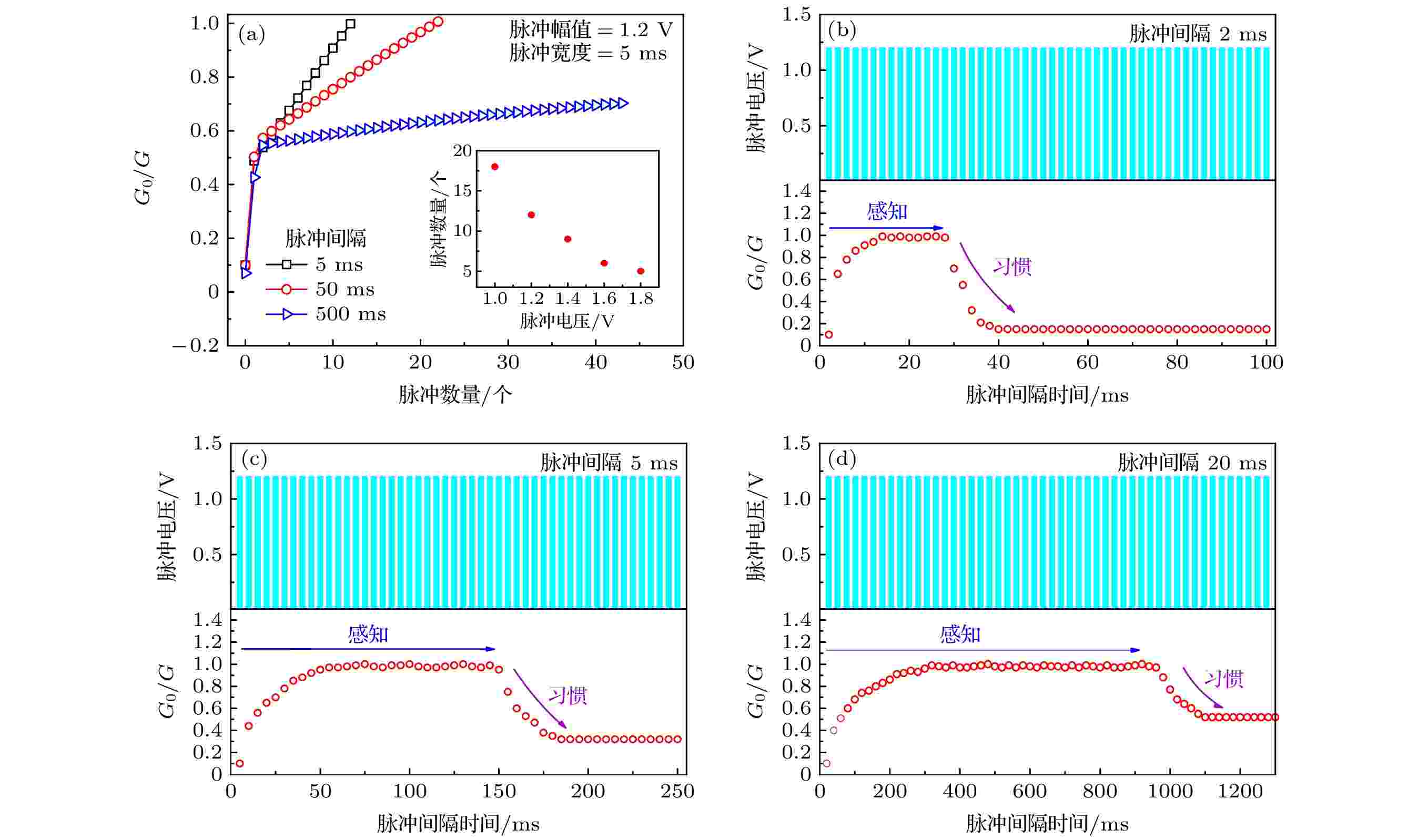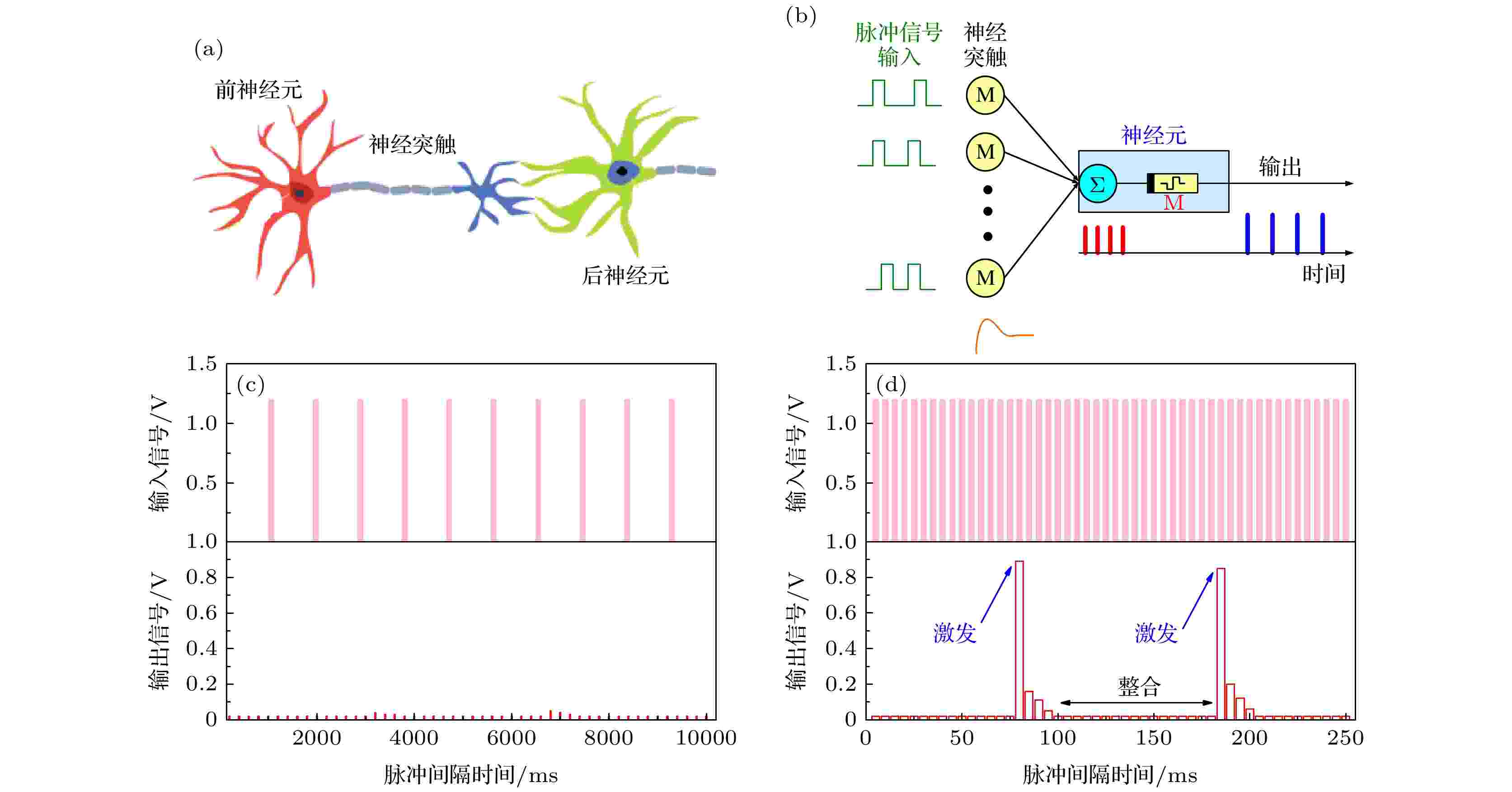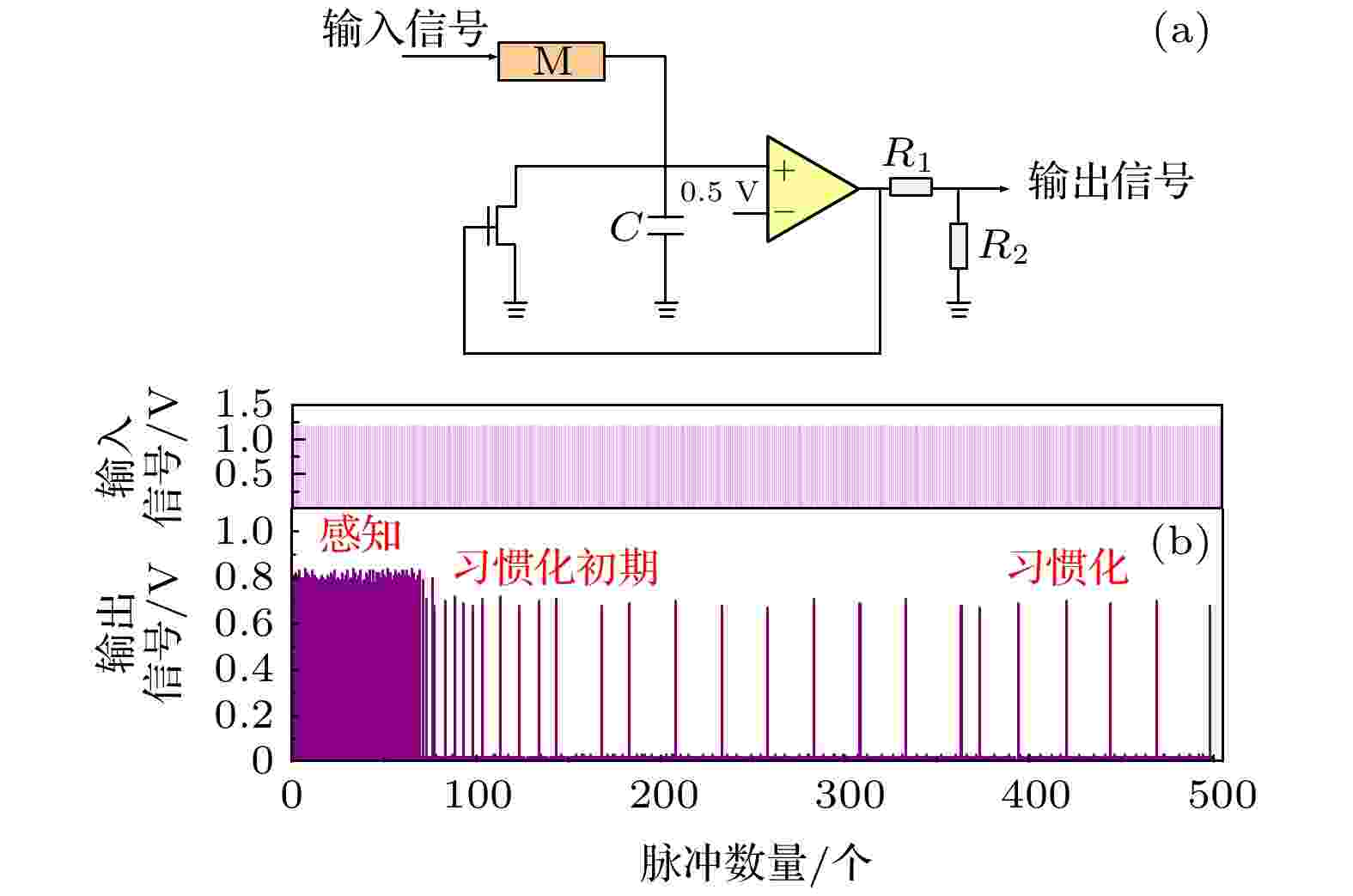全文HTML
--> --> --> 图 1 铝基薄膜的TEM和XPS测试 (a) XPS测试(BE, 结合能); (b) TEM测试
图 1 铝基薄膜的TEM和XPS测试 (a) XPS测试(BE, 结合能); (b) TEM测试Figure1. The TEM and XPS results of nc-Al embedded AlN thin film: (a) XPS result (BE, binding energy); (b) TEM result.
以含有铝纳米颗粒的AlN薄膜为基础的忆阻器I-V测试结果如图2(a)所示. 第一次测试施加0—1.2 V正向电压时, 忆阻器电流在约1.1 V时瞬间从约10–7 A增大到约10–2 A, 器件同时从高阻态(high resistance state, HRS)向低阻态(low resistance state, LRS)转变, 这一过程称为忆阻器开启(switch on); 第二次测试在同个器件上再次施加0—1.2 V正向电压时, 忆阻器电流在约0.3 V时瞬间从约10–2 A降低到约10–7 A, 器件则从LRS向HRS转变, 这一过程称为忆阻器关闭(switch off). 第三次和第四次进行反向电压I-V测试可以得到类似的电学特性结果. 由于忆阻器打开和关闭过程都发生在同极电压测试中, 这符合单极忆阻器(unipolar memristor)特性. 图1(b)是忆阻器在电压低于0.3 V时对电流进行幂律拟合的结果. 可以看出, 无论器件处于LRS还是HRS幂律拟合的n值都近似等于1, 表明器件内部低电压时的电流更符合欧姆传导机制. 导电丝原理就更适合解释本文忆阻器的阻变特性[27-30]. 图2(c)所示为忆阻器在HRS和LRS状态下导电丝的不同分布情况. 忆阻器HRS时导电丝呈现断开状态, LRS则对应导电丝连接状态. 铝基薄膜忆阻器中的导电丝性质更近似于金属, 主要由薄膜内部缺陷、活跃金属离子和铝纳米颗粒构成. 当测试电压升高至约0.3 V以上, 电流线性拟合发生偏离, 处于HRS的器件电荷传导机制不再符合欧姆传导, 而更接近于肖特基发射机制, 如图2(d)所示. 这是由于逐渐增加的电场会引起器件内电荷传输倾向于能量更高的传输形式[27].
 图 2 忆阻器的电学特性和阻变原理 (a) 铝基薄膜忆阻器I-V测试显示单极(unipolar)特性; (b) 忆阻器的I-V测试在低电压时的幂律拟合; (c) HRS下器件内导电丝处于断开状态, LRS下器件内导电丝处于连接状态; (d) 器件HRS下的电荷传导机制
图 2 忆阻器的电学特性和阻变原理 (a) 铝基薄膜忆阻器I-V测试显示单极(unipolar)特性; (b) 忆阻器的I-V测试在低电压时的幂律拟合; (c) HRS下器件内导电丝处于断开状态, LRS下器件内导电丝处于连接状态; (d) 器件HRS下的电荷传导机制Figure2. Electrical and resistive switching theory of memristor: (a) The I-V characteristic of memeristor shows unipolar property; (b) the power-law fitting of memeristor I-V measurement at low voltage region; (c) conductive filaments broken at HRS and connected at LRS; (d) conduction mechanisms of memristor at HRS.
在神经系统中, 脉冲信号测试更贴近实际的神经系统活动, 而神经突触是连接各神经元进行信息传递的枢纽, 主要接受的是脉冲信号的传递. 具有习惯化特性的神经突触可以排除重复信号的干扰, 让主体更快适应外部环境的变化. 神经突触的权值越大代表信息传递越紧密. 忆阻器在模拟神经突触功能中, 其电导率对应了神经突触的权值, 即电导率越高, 流经器件的电流越大, 对应了神经突触在信息传递中; 若电导率下降, 则意味流经电流降低, 神经突触就没有进行信息传递[31,32]. 将制备的铝基薄膜忆阻器进行脉冲电压测试, 可明显观察到器件表现出跟神经突触很相近的习惯化特性. 本文将忆阻器的电导率用测量值除以最大值, 即G0/G表达器件权值, 可以更清楚展示忆阻器模拟神经突触的特性, 并设定该值应在0—1中变化.
图3(a)所示为器件权值在脉冲数量和不同脉冲间隔(脉冲频率)影响下的变化, 以及器件权值达到最大值所需脉冲数量与脉冲电压幅值的关系. 在器件上施加幅值为1.2 V, 宽度为5 ms, 脉冲间隔为5 ms的脉冲电压, 仅需要12个脉冲器件权值就可以达到最大值; 当脉冲间隔增加到50 ms时, 器件权值就需要23个脉冲刺激才可以达到最大值; 当脉冲间隔增加到500 ms时, 器件权值几乎无法在有限量程内达到最大值. 这是由于脉冲间隔的实质是反映了外界刺激的频率, 由此可见频率过小的外界刺激难以将权值激励到最大值, 若权值不够高可能在神经网络的应用中就不够形成有效输出. 因此在进行脉冲电压测试时, 脉冲间隔应选择在50 ms以下. 图3(a)插图部分给出了脉冲电压幅值和引起器件电导率最大值所需脉冲数量的关系, 幅值越大所需脉冲数量越少. 图3(b)—(d)给出了在不同脉冲间隔下, 器件的感知和习惯化过程. 如图3(b)所示, 当测试脉冲幅值为1.2 V, 宽度为5 ms, 脉冲间隔为2 ms时, 忆阻器在感知过程中电导率很快达到最大值~1. 继续施加脉冲时, 权值在第9个脉冲开始从最大值逐渐降低至0.15. 此后继续施加脉冲不能引起器件电导率的明显变化, 呈现了类似神经突触的习惯化特性. 若将脉冲幅值保持不变, 将信息传递频率降低, 也就是将脉冲间隔提高到5和 20 ms时, 器件电导率分别在第19个和第34个脉冲开始逐渐下降到0.32和0.52左右, 继续施加脉冲电压并未引起器件电导率的明显变化. 从结果可知, 频率较高的脉冲刺激可以让器件更快速地进入习惯化过程, 而频率较低的脉冲刺激则需要更久的时间才能引起器件的习惯化特性.
 图 3 忆阻器的脉冲电压测试显示了习惯化特性 (a)间隔越大导电率到达最大值所需的脉冲数量越多; 脉冲电压越大导电率到达最大值所需的脉冲数量越少, 如插图所示; (b)脉冲电压1.2 V, 间隔2 ms时器件感知和习惯化测试; (c) 脉冲电压1.2 V, 间隔5 ms时器件感知和习惯化测试; (d) 脉冲电压1.2 V, 间隔20 ms时器件感知和习惯化测试
图 3 忆阻器的脉冲电压测试显示了习惯化特性 (a)间隔越大导电率到达最大值所需的脉冲数量越多; 脉冲电压越大导电率到达最大值所需的脉冲数量越少, 如插图所示; (b)脉冲电压1.2 V, 间隔2 ms时器件感知和习惯化测试; (c) 脉冲电压1.2 V, 间隔5 ms时器件感知和习惯化测试; (d) 脉冲电压1.2 V, 间隔20 ms时器件感知和习惯化测试Figure3. Memristor exhibit habituation property in voltage pulse measurement: (a) The longer pulse interval need more pulse number to cause memristor conduction maximized and the larger pulse amplitude need less pulse number to cause memristor conduction maximized, as shown in inset figure; (b) learning and habituation measurement of memristor with pulse voltage 1.2 V and pulse interval 2 ms; (c) learning and habituation measurement of memristor with pulse voltage 1.2 V and pulse interval 5 ms; (d) learning and habituation measurement of memristor with pulse voltage 1.2 V and pulse interval 20 ms.
在之前的测试中明确了脉冲频率会对器件的习惯化产生影响, 其关系如图4(a)所示. 若固定脉冲幅值和宽度为+1.2 V和5 ms, 脉冲间隔分别为2, 5, 10, 20和50 ms时, 器件发生习惯性行为所需脉冲分别为9, 19, 26, 34和85个; 若固定脉冲幅值和宽度为–1.2 V和5 ms, 脉冲间隔分别为2, 5, 10, 20和50 ms时, 器件发生习惯性行为所需脉冲分别为30, 48, 66, 90和220个. 可见频率越低的刺激能够引起器件习惯化行为所需的时间越长, 与之前的推论符合. 图4(b)所示为脉冲幅值和器件发生习惯性行为所需脉冲之间的关系. 若固定脉冲宽度和间隔都为5 ms, 正向脉冲幅值从1.2 V逐渐增大到1.6 V时, 器件引起习惯化行为所需的脉冲数量从19个降低至4个左右; 若固定脉冲宽度和间隔都为5 ms, 负向脉冲幅值从–1.2 V逐渐增大到–1.6 V时, 器件引起习惯化行为所需的脉冲数量从45个降低至10个左右. 可见脉冲幅值越高, 会更快地引发器件的习惯化特性. 这一现象的本质原因与含有铝纳米颗粒的AlN薄膜阻变特性相关: 导电丝在电压影响下可以由断开变为连接, 以提高器件导电率; 但持续较高的电压刺激又会在导电丝上产生过多热量导致其熔断, 导电率因此而下降, 即观察到的忆阻器习惯化特性显现. 另外, 活跃金属银作为顶电极, 也会在电场作用下迁移进入或者离开阻变层, 参与到导电丝的连接和断开过程中[33,34]. 同时从图4(a)和图4(b)可知, 负向脉冲需要更多的脉冲数量才能引起器件习惯化, 主要是由器件的非对称结构, 即上电极为银, 下电极为铝而引起的. 在负向脉冲刺激下, 顶电极的银离子在该电场方向下无法迁移到阻变层参与导电丝连接或断开, 因此器件需要更多的脉冲刺激才能实现阻变特性.
 图 4 器件引起习惯化所需脉冲数量与脉冲间隔和脉冲电压幅值的关系 (a) 固定脉冲幅值和宽度, 脉冲间隔越大引起器件习惯化特性所需的脉冲数量越多, 负向脉冲比正向脉冲需要更多的脉冲数量引起器件习惯化; (b) 固定脉冲间隔和宽度, 脉冲电压越大引起器件习惯化特性所需的脉冲数量越少, 负向脉冲比正向脉冲需要更多的脉冲数量引起器件习惯化
图 4 器件引起习惯化所需脉冲数量与脉冲间隔和脉冲电压幅值的关系 (a) 固定脉冲幅值和宽度, 脉冲间隔越大引起器件习惯化特性所需的脉冲数量越多, 负向脉冲比正向脉冲需要更多的脉冲数量引起器件习惯化; (b) 固定脉冲间隔和宽度, 脉冲电压越大引起器件习惯化特性所需的脉冲数量越少, 负向脉冲比正向脉冲需要更多的脉冲数量引起器件习惯化Figure4. Relationship of the number of pulses required for device habituation to the pulse interval and pulse voltage: (a) The relationship between the number of pulses required for device habituation and pulse interval with fixed pulse voltage and width; (b) the relationship between the number of pulses required for device habituation and pulse voltage with fixed pulse interval and width.
根据忆阻器特性, 习惯化行为产生后, 器件不会永久处于高阻值状态; 若重新施加高电压或高频率刺激, 导电丝可能再次重新连接使器件回到高导电状态, 这一过程也被称为去习惯化过程. 习惯化和去习惯化行为都属于神经系统的基本功能.
在神经系统中, 神经元之间由神经突触相连, 结构如图5(a)所示, 信息以脉冲序列的方式通过神经突触由前神经元传递给后神经元. 每个神经元在接收到固定的输入脉冲信号后, 都可发出与自身相关的幅值相等但频率略低的输出脉冲信号. 感觉神经系统的信号处理过程可以用LIF模型模拟[35,36], LIF模型结构如图5(b)所示. 和神经元相连的各个神经突触可接收到不同频率和幅值的脉冲信号, 这类信号在脉冲神经网络中称为时空信号. 不同幅值和频率的时空信号传递到神经元时, 神经元接收后可根据自身属性发出特有频率的输出脉冲信号. 这里的神经元可用阈值忆阻器实现, 即阈值忆阻器接受足够信号刺激并超过自身阈值时, 才会释放出一个自身特有幅值的脉冲信号. 当刺激信号持续时, 阈值忆阻器就可以释放出一连串特有频率的信号, 通常频率会低于输入信号. 只有足够高频率的输入信号才可以引起阈值忆阻器的激发. 这一过程可通过图5(c)和图5(d)展示, 当输入信号频率过低时并不能引起阈值忆阻器激发, 即神经元不对此类信号作出反应, 如图5(c)所示. 当输入信号频率增加时, 阈值忆阻器才可被激发, 发出更低频率的输出信号, 如图5(d)所示. 此时, 神经元开始进行信息传递.
 图 5 感觉神经系统的工作原理[10] (a) 神经系统结构图; (b) 神经系统的LIF模型; (c)频率较低的输入信号不能引起神经元的激发; (d) 频率较高的输入信号引起神经元激发
图 5 感觉神经系统的工作原理[10] (a) 神经系统结构图; (b) 神经系统的LIF模型; (c)频率较低的输入信号不能引起神经元的激发; (d) 频率较高的输入信号引起神经元激发Figure5. Working principle diagram of sensory nervous system (SNS)[10]: (a) Structure of SNS; (b) LIF model of SNS; (c) no firing observed with low frequency input pulse signal; (d) firing of neuron observed with high frequency input pulse signal.
为了验证具有习惯化特性忆阻器作为神经突触在LIF模型中的优势, 本文将含有铝纳米颗粒的铝基薄膜忆阻器M接入图6(a)所示的电路中. 比较器可以设定阈值电压为0.5 V, 电容C (约120 pF)提供存储电荷的功能, 电阻R1 (约2 kΩ)和R2 (约150 Ω)承担分压功能可以将输出脉冲电压幅值稳定在目标范围内, 另外还需一个接地N型金属-氧化物-半导体晶体管提供放电功能. 在整个电路中, 具有习惯化特性忆阻器提供输入端的输入信号. 输入脉冲电压统一幅值为1.2 V, 宽度和间隔都为5 ms的500个连续脉冲电压.
 图 6 神经系统LIF模型习惯化特性测试 (a) 含有习惯化特性忆阻器的LIF模型图; (b) 连续脉冲测试, 展示了习惯化特性对完整神经系统的影响
图 6 神经系统LIF模型习惯化特性测试 (a) 含有习惯化特性忆阻器的LIF模型图; (b) 连续脉冲测试, 展示了习惯化特性对完整神经系统的影响Figure6. Habituation measurement of LIF model: (a) LIF model structure with habituation memristor; (b) the effect of habituation memristor in LIF model with continuous pulse stimuli.
输出信号如图6(b)所示, 连续的脉冲刺激通过习惯化忆阻器传递到神经元, 在最初的感知过程中, 输出脉冲频率几乎与输入脉冲频率一致, 约为200 Hz. 这是由于忆阻器对脉冲刺激的实时传递直接将输入信号传递给神经元, 在强烈脉冲刺激下神经元给出了频率较高的反馈. 再继续施加输入脉冲电压, 就会引起忆阻器的习惯化特性, 此时的器件电导率逐渐降低, 导致电容放电频率变慢, 输出脉冲频率也相应降低到40 Hz左右, 可称为习惯化初期. 当输入脉冲电压累积到一定数量后就会引起忆阻器完全的习惯化特性, 器件导电率也保持在较低的水准, 引起输出频率继续降低到8 Hz左右, 此时的神经系统已经完全适应这种连续刺激, 不会再针对此类重复刺激作出激烈反应, 直到下一个不同的刺激信号到来. 具有习惯化特性的神经系统更贴合生物机体本能, 对于重复发生的事件, 生物体在经历习惯化后给出的反馈时间会明显缩短. 这更有利于神经系统高效率地处理较为复杂的脉冲信号, 也符合本文一开始提到的具有习惯化特性的神经系统应对重复外界刺激逐渐降低自身反应频率的设定.
